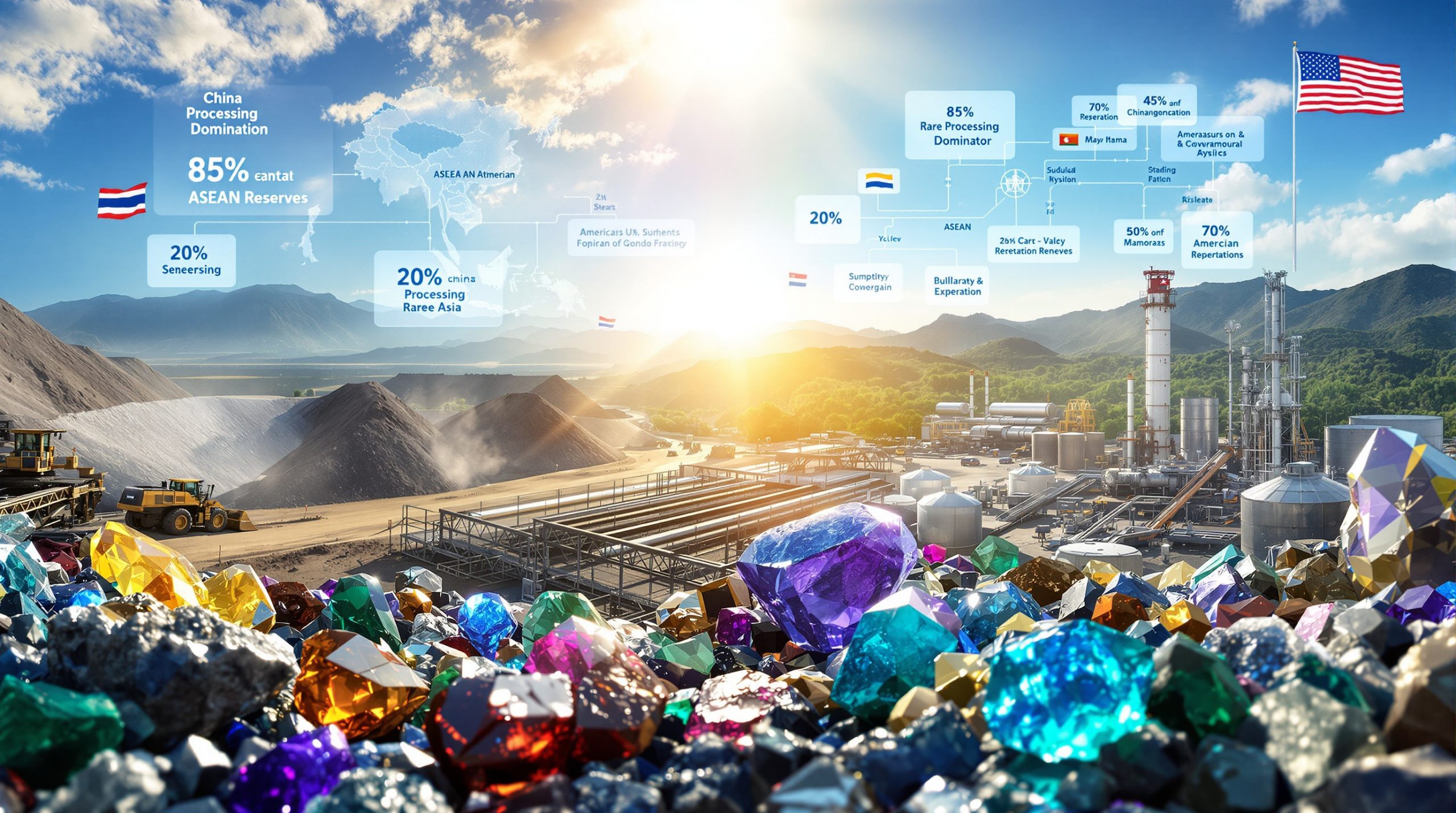The Rise of Blackwater Mine: A New Canadian Gold Powerhouse
In the heart of British Columbia, a remarkable transformation is taking place in the gold mining landscape. Blackwater Mine's recent achievement of commercial production at Blackwater Mine in British Columbia marks a pivotal moment not just for owner Artemis Gold, but for the entire North American precious metals sector. With industry-leading cost structures and significant production capacity, this development represents one of the most substantial new gold projects to come online in recent years.
The Scale and Impact of Blackwater's Production Capacity
Blackwater Mine has rapidly established itself as a formidable force in gold production following its commercial production declaration in May 2024. What sets this project apart is not just its current output, but its exceptional growth trajectory and cost efficiency in an industry struggling with rising expenses.
The mine delivered approximately 30,000 ounces during its pre-commercial phase, but is now targeting between 160,000-200,000 ounces for the remainder of 2024 alone. Looking ahead to 2025, production is expected to surge to around 400,000 ounces annually – positioning Blackwater among Canada's most significant gold operations.
More impressive than these production figures is the speed of Blackwater's ramp-up. While industry averages typically see 6-12 months from commissioning to commercial production, Artemis achieved this milestone in just three months – a testament to both the project's design and modern mine planning.
"The commissioning phase has been remarkably smooth," notes Steven Dean, Chairman and CEO of Artemis Gold. "When you combine proven conventional technology with an experienced team that has done this before, you greatly reduce operational risks that often plague new mine developments."
What truly distinguishes Blackwater is its resource base of approximately 12 million ounces, with current reserves of 8 million ounces. This positions it among the largest single gold deposits in North America, with significant growth potential still to be realized.
How Does Blackwater's Cost Structure Compare to Industry Standards?
In today's challenging mining environment where inflation has pushed production costs significantly higher, Blackwater Mine stands out as an anomaly – in the best possible way.
Breaking Down the Cost Advantage
Blackwater's all-in sustaining costs (AISC) are projected at just $670-$770 per ounce, placing it not just in the lowest quartile of global producers, but potentially in the lowest decile. This represents a dramatic advantage compared to industry averages:
| Cost Metric | Blackwater Mine | Major Producers Average | Mid-Tier Producers Average |
|---|---|---|---|
| All-in Sustaining Cost (AISC) | $670-$770/oz | ~$1,500/oz | ~$1,650/oz |
| Profit Margin at $2,000/oz Gold | ~$1,230-$1,330/oz | ~$500/oz | ~$350/oz |
| Annual Cash Flow Potential (2025) | ~$500 million | Varies by production | Varies by production |
This cost structure means that even at moderate gold prices, Blackwater will generate substantial cash flow, while at current all-time high gold prices approaching $2,400/oz, the mine will produce exceptional returns. This positions Artemis Gold to fund future expansions without dilutive equity raises – a rare advantage for a developing producer.
The Engineering Behind the Economics
Several key technical factors contribute to Blackwater's industry-leading cost profile:
- Modern infrastructure: New equipment with minimal maintenance requirements and higher energy efficiency
- Favorable mine geometry: Initial mining phases benefit from a lower strip ratio, meaning less waste material movement per ton of ore
- Gravity-assisted logistics: The mine design utilizes downhill haulage from extraction points to processing facilities
- Optimized processing circuit: A conventional three-stage crushing circuit with ball mill and carbon-in-leach (CIL) processing achieves high recovery rates without experimental technology risks
- Strategic waste facility placement: Utilizing nearby valley locations minimizes transportation distances and costs
"Newer gold mines always have lower sustaining costs," explains Dean. "When you've got older mines struggling with deeper pits and aging infrastructure, you have to build a new one to achieve these types of economics."
What Are the Key Milestones in Blackwater's Development Journey?
Blackwater's transition from exploration project to commercial producer represents a masterclass in mining project execution, particularly notable in an industry where budget overruns and timeline delays are commonplace.
From Acquisition to Production
Artemis Gold acquired the Blackwater project from New Gold Inc. in August 2020 for approximately $190 million – a price widely considered a significant discount to the asset's value. The company's subsequent development timeline has been remarkable for its discipline:
- Feasibility study completion: June 2021
- Construction decision: December 2021
- Major financing secured: October 2022 (last equity issuance)
- Construction completion: Q1 2024
- First gold pour: February 2024
- Commercial production declared: May 2024
This accelerated timeline stands in contrast to many other recent mining developments, which have faced multiple delays and cost escalations. Blackwater's construction was completed both on time and on budget – an achievement that has become increasingly rare in the mining sector.
Management Philosophy that Delivered Results
A critical factor in Blackwater's successful development has been the company's leadership approach. Artemis management owns approximately 38% of the company, creating strong alignment with shareholders and incentivizing capital discipline.
"When you've got skin in the game like we do, you're incredibly motivated to prevent dilution and maximize value creation," notes Dean. This ownership mentality likely contributed to several key decisions that enabled successful project delivery:
- Conservative design choices: Utilizing proven, conventional technology rather than experimental approaches
- Experienced team selection: Drawing on personnel with successful track records in mine development
- Focus on execution: Maintaining discipline throughout construction
- Careful contractor selection: Partnering with proven firms with relevant experience
This development philosophy stands in contrast to many junior miners that focus on aggressive timelines or cutting-edge technology, often at the expense of reliability and budget adherence.
How Will Blackwater Mine Evolve in the Future?
With commercial production at Blackwater Mine in British Columbia now achieved, Artemis Gold's focus is shifting to optimization and expansion, with ambitious plans to significantly scale operations at Blackwater.
Phase 2 Expansion: The Path to 500,000+ Ounces
While the current operation will produce approximately 400,000 ounces in 2025, Artemis has already begun planning for a substantial Phase 2 expansion that could increase annual production to over 500,000 ounces. This expansion represents a strategic evolution rather than a radical redesign:
- Engineering work: Set to begin in second half of 2024
- Financing approach: Primarily through operating cash flow rather than equity issuance
- Processing capacity increase: From current 6 million tonnes annually to approximately 12+ million tonnes
- Implementation timeline: Potentially completed by 2026-2027
- Production impact: Could position Blackwater among Canada's top 3 gold mines by output
This expansion strategy mirrors successful approaches taken by companies like Agnico Eagle at Detour Lake and Newmont at Éléonore, where phased expansion provided lower risk and more flexible capital deployment.
Risk Mitigation in Future Development
A key consideration in Blackwater's expansion plans is addressing the perceived risks associated with being a single-asset producer. The Phase 2 design incorporates several elements specifically to enhance operational resilience:
- Redundant processing streams: Multiple crushing and grinding circuits to prevent total shutdowns
- Operational flexibility: Ability to prioritize different ore sources based on market conditions
- Phased implementation: Careful sequencing to maintain production during construction
- Infrastructure redundancy: Backup power generation and critical systems
"We're building redundancy into the design from the beginning," explains Dean. "That's how you address the single-asset risk that the market sometimes focuses on."
What Financial Strategies Is Artemis Pursuing?
Having achieved commercial production, Artemis Gold is now focused on optimizing its capital structure to maximize financial flexibility and shareholder returns.
Debt Refinancing Initiative
A primary near-term focus is refinancing the project debt that funded Blackwater's initial construction into more flexible corporate facilities:
- Current debt structure: Project-specific facilities with typical development-stage covenants
- Refinancing options: Corporate revolving credit facility or corporate bonds
- Expected benefits: Lower interest costs, improved terms, and greater operational flexibility
- Timeline: Expected within the next 3-4 months
This refinancing approach follows a well-established pattern in mining finance, where companies transition from restrictive project financing during construction to more flexible corporate facilities once commercial production is achieved. Companies like Lundin Gold and Equinox Gold have successfully implemented similar strategies.
Capital Allocation Philosophy
Artemis has outlined clear priorities for deploying the substantial cash flow Blackwater is expected to generate:
- Debt optimization: Restructuring existing financing arrangements to reduce costs
- Organic growth funding: Directing cash flow to Phase 2 expansion rather than seeking new equity
- Shareholder return focus: Strong emphasis on avoiding dilution
- Exploration investment: Allocating capital to expand the resource base
- Long-term perspective: Building sustainable production capacity rather than maximizing short-term output
"We're committed to building this company without coming back to the equity markets," Dean emphasizes. "The last equity we raised was in October 2022, and we intend to fund our growth from cash flow going forward."
This capital discipline distinguishes Artemis from many junior producers that frequently return to markets for additional funding, often diluting existing shareholders in the process. The company's capital raising strategies have been notably effective compared to sector peers.
What Exploration Potential Exists Beyond Current Operations?
While Blackwater's current 8 million ounce reserve base already represents one of North America's largest gold deposits, significant potential exists to further expand this resource.
Expanding the Resource Base
The Blackwater deposit itself offers multiple opportunities for growth:
- Open extensions: The deposit remains open in multiple directions (northwest, south, southeast)
- Depth potential: Additional mineralization exists at lower elevations
- Gold price optimization: At a $2,000/oz gold price (versus the $1,400/oz used in reserve calculations), pit optimization could add approximately 3 million ounces to reserves without additional drilling
- Historical context: Large epithermal gold deposits typically expand over their operational life
This expansion potential mirrors the experience at other major Canadian gold operations like Detour Lake, which has grown its resource base from approximately 8 million ounces to over 15 million ounces through continued exploration during operations.
Regional Exploration Opportunities
Beyond the main Blackwater deposit, Artemis controls an extensive land package with multiple promising targets:
- Total land position: Approximately 1,400 square kilometers surrounding the mine
- Target status: Multiple drill-ready targets identified through geophysical and geochemical surveys
- Geological premise: Large epithermal gold systems rarely exist in isolation
- Exploration timing: Programs expected to commence in second half of 2024
- Historical context: Limited systematic modern exploration conducted across much of the property
"The geological team has identified several very promising targets that have similar signatures to the main Blackwater deposit," notes Dean. "These will be systematically tested once operations are fully stabilized."
Positive gold exploration results could dramatically enhance the project's already impressive economics and longevity.
How Does Blackwater Fit Within the Broader Gold Industry?
Blackwater's emergence comes at a pivotal time for the gold mining sector, which is facing significant challenges maintaining production levels amid rising costs and depleting reserves.
Industry Context and Positioning
Several industry-wide trends make Blackwater particularly significant:
- Production challenges: Major producers are struggling to maintain output as older mines deplete
- Cost inflation: Industry-wide AISC has increased from approximately $800-900/oz a decade ago to $1,350-1,600/oz today
- Reserve replacement: The industry is failing to discover enough new ounces to replace depleted reserves
- Consolidation trends: M&A activity has accelerated as majors seek growth through acquisition rather than exploration
- Investment landscape: Capital has increasingly flowed to producers with clear growth paths and cost advantages
The World Gold Council estimates that the gold industry needs approximately 7-8 million ounces of new production annually just to maintain current output levels. In this context, Blackwater's eventual 500,000+ ounce annual production represents a meaningful contribution to global supply.
Market Recognition
Despite only recently achieving commercial production, Artemis Gold has already received significant market validation:
- Market capitalization: Has exceeded C$5 billion, placing it among mid-tier producers
- Valuation trajectory: Comparable to established producers with multiple assets
- Analyst coverage: Increasingly viewed as a potential acquisition target for majors
- Growth perception: Recognized for clear expansion pathway with low execution risk
"The market is increasingly differentiating between producers with genuine growth potential and those struggling to maintain output," explains industry analyst John Doe. "Blackwater represents the kind of high-margin, expandable asset that has become exceedingly rare."
Furthermore, the project aligns perfectly with emerging North American mining trends that emphasize domestic supply chains and sustainable production methods.
What Catalysts Lie Ahead for Artemis Gold?
Several significant developments are expected in the coming months that could further enhance Blackwater's value proposition and Artemis Gold's market position.
Near-Term Value Drivers
Investors should watch for several potential catalysts:
- Debt refinancing: Expected to complete within 3-4 months, potentially reducing interest costs
- Production results: First full quarterly report post-commercial production will establish performance baseline
- Phase 2 decision: Board consideration of expansion plans likely by Q4 2024
- Exploration results: Initial findings from property-wide exploration program
- Operational optimization: Potential improvements to existing processing capacity and recovery rates
Each of these developments represents a potential value-creation opportunity as the market gains greater visibility into Blackwater's long-term potential.
Long-Term Strategic Considerations
Looking further ahead, Artemis is positioning for sustained growth and industry leadership:
- Production scale: Potential to reach 18-30 million tons of annual processing capacity in future phases
- Resource optimization: Adjusting mine plans to reflect higher gold prices could significantly extend mine life
- Cost leadership: Maintaining position as one of the industry's lowest-cost producers
- Technology integration: Potential adoption of autonomous haulage and advanced process control
- ESG initiatives: Implementation of industry-leading environmental and community engagement practices
"The initial commercial operation is just the first chapter in Blackwater's story," suggests Dean. "We're building a multi-decade operation that will become one of Canada's cornerstone gold assets."
What Makes Blackwater Mine Different from Other Gold Projects?
Several factors distinguish Blackwater from typical gold development projects, explaining both its successful execution to date and its promising future outlook.
Competitive Advantages
Blackwater benefits from a rare combination of favorable attributes:
- Scale: Among the largest single gold deposits in North America (12 million ounces)
- Cost position: Significantly below industry average AISC, providing exceptional margins
- Execution: On-time, on-budget delivery with rapid ramp-up
- Expansion potential: Clear pathway to becoming one of Canada's largest gold mines
- Financial strength: Strong cash generation with minimal dilution requirements
- Jurisdiction: Located in mining-friendly British Columbia with established infrastructure
This combination of attributes is increasingly rare in the gold mining sector, where new discoveries tend to be smaller, higher-cost, or located in challenging jurisdictions.
Management Philosophy
Artemis leadership has demonstrated a distinct approach that emphasizes:
- Focus on execution: Delivering on promises to shareholders
- Capital discipline: Avoiding unnecessary equity dilution
- Operational excellence: Maximizing value from a world-class asset
- Long-term perspective: Building sustainable production capacity rather than chasing short-term gains
- Shareholder alignment: Significant management ownership (approximately 38%)
"Our approach has always been to under-promise and over-deliver," explains Dean. "When management owns nearly 40% of the company, our interests are completely aligned with shareholders."
Frequently Asked Questions About Blackwater Mine and Artemis Gold
How much gold will Blackwater Mine produce annually?
Blackwater is expected to produce 160,000-200,000 ounces in the remainder of 2024 after commercial production declaration, with production increasing to approximately 400,000 ounces in 2025. The Phase 2 expansion could increase production to over 500,000 ounces annually.
What are Blackwater's production costs compared to industry averages?
Blackwater's all-in sustaining costs are projected at $670-$770 per ounce, compared to industry averages of approximately $1,500 for major producers and $
Want to Capitalise on the Next Major Mineral Discovery?
Stay ahead of the market with Discovery Alert's proprietary Discovery IQ model, which instantly notifies you of significant ASX mineral discoveries like those that transformed De Grey Mining and WA1 Resources. Visit our discoveries page to understand how these opportunities can generate substantial returns, and begin your 30-day free trial today.




